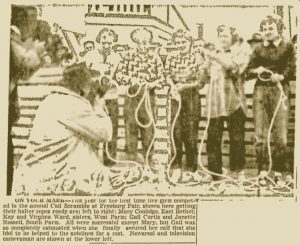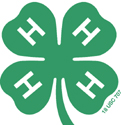4-H Fix: Scrambling to Change the World
Scrambling to Change the World
By Ron Drum, Statewide 4-H Program Professional/Associate Director 4-H Resource Development
Welcome!
 Welcome to what we hope will become your monthly “4-H Fix”!
Welcome to what we hope will become your monthly “4-H Fix”!
A newspaper out of New York City, the New York Times, has, since 1897, sold itself as the paper that prints “all the news that’s fit to print.” Well, dare I suggest that 4-H Fix is the blog that tells all the Maine 4‑H Stories that are fit to tell?
Perhaps not. But we do hope to tell lots of Maine 4-H stories! Some old and some new, always borrowed ideas, but, we hope, never blue. Apparently, I’m in the mood of stealing slogans today. So, in hopes of making the best better (you had to have seen that coming), I’ll get to the point.
Each month you’ll find something of interest concerning Maine 4-H at 4-H Fix. It may be a story about a present 4-H member or 4-H volunteer. It may be a story about a past 4-H event, of recent past or less recent past! It may be a story about a former 4-H member. The key point is, it’ll be about 4-H in Maine.
We hope it’ll be entertaining. Since it is 4-H, it better be educational. And since this is Maine, it will always be the way life should be, following the lead of the 4-H Clover!
For example, and as our first offering, we’ll begin with the story of how two women, 4-H members both, helped change the world!
How two women, 4-H members both, helped change the world!
Sixty-five years ago two girls made a decision that shocked the status quo, made news then, and is recounted history today. Two Maine 4-H Members took their place in the line of people who helped change the way we think of girls and women today.
The year was 1951. It was a year to be remembered. The United Nations was fighting the second year of the Korean War. Harry Truman, who was President in 1951, fired General MacArthur. American citizens were introduced to color television that year and those who had one, saw, for the first time ever, an image of the Atlantic and Pacific Oceans broadcast simultaneously, if they watched the first episode of Edward R. Murrow’s TV show, “See It Now.” Another TV show that premiered that fall to the delight of many was “I Love Lucy.” A postage stamp cost 3 cents, the Yankees won the World Series, and two young women, sisters from West Paris, Maine, became national celebrities, for a while at least.
Kay and Virginia Ward, ages 15 and 16, were in their second year of 4-H Membership and both of the girls chose 4-H Baby Beef as their 4-H Project that year. They wanted Herefords to raise, but the prospect of their getting Herefords was slim at best, that is until they both decided to try to win one during the 5th Annual Fryeburg Fair Calf Scramble.
They entered the Calf Scramble, something no girl had ever done before, nor had anyone envisioned a girl ever doing! They registered for what most people had come to think of as something only BOYS do! Usually, during a Calf Scramble, 12 to 15 boys enter a ring in which 11-14 (one less calf than boys) untamed (“wild” is a better word for it) yearling Hereford calves have been corralled. At the start of the event, the boys rush toward the calves with the goal of placing a rope halter on one of the animals and leading it to the center of the ring thus winning that calf to take home and raise as their 4-H project to be shown and sold during the following year’s fair. Of course, the calves don’t want to be haltered and led to the center of the ring, or anywhere else for that matter, so do all they can to keep the contestants’ goals unfulfilled.
That 1951 Fryeburg Fair Calf Scramble was anything BUT “usual.” The Ward sisters changed everything; even the way folks talked about the event. Boys no longer competed for the calves, contestants did! Some people said, “It’s against the rules!” But it wasn’t. The rules said the contestants had to be at least 15 years old and enrolled in a 4-H Club. Kay was 15, Virginia was 16, and they both were enrolled in the Hungry Hollow Hie-Hoe 4-H Club. By the rules, they qualified.
However, calf scrambles are dangerous. The animals may not yet be a year old, but they are very large animals, all the same. The Hereford Kay eventually caught weighed 265 pounds; Virginia’s weighed 394. While describing the scramble of 1953 Virginia wrote, “Carroll got jumped on and dislocated his left shoulder, but got his calf just the same.” A cry went up, “But these are GIRLS! GIRLS might get hurt!” The sisters pointed out, however, that boys could get hurt as well, that they do nothing less on their own farm back home, and, besides, the rules didn’t say “BOYS ONLY.” So, on that warm and sunny October 4, 1951, Kay and Virginia took their place alongside the astonished boys, ready to capture themselves a Hereford calf. Actually, their registering for this event opened a small floodgate as it encouraged three more girls to enter as well: Gail Curtis, Mary Coolidge, and Janette Russell, placing five girls beside the six boys who entered the 1951 Fryeburg Fair Calf Scramble.
Having girls compete was not something lost on the fairgoers that year either. As the contestants stood to wait for the event to begin, there was much discussion, and some derision (Virginia referred to it as “jeering”), by the audience gathered to watch the event. When the event was over and four of the five girls had successfully captured a calf, Kay and Virginia included, and no one had gotten hurt, Virginia wrote, “I imagine there were a few surprised people when we got done.”

This scramble was news. It was in all the papers.
Clearly, however, the news was not about young people participating in a fair event. It was that girls had attempted to, and been successful at, doing what until then only BOYS did! They captured calves just like the boys! The Lewiston Daily Sun included a photo of the five girls taken just prior to the start of the event. The photo did not include any of the boys, just the five girls. The caption reported that four of the girls were successful in capturing a calf but noted that, although successful, one of the girls had to be helped from the ring due to exhaustion. Another newspaper caption reported, “The fair sex had their day in the fifth annual Calf Scramble at Fryeburg Fair Thursday with four of the five lassies emerging from the ring victorious along with six male contestants.” One headline read, “Four Oxford County Girls Prove as Adept Unscrambling Calves as Scrambling Eggs.” The article opened with, “Four Oxford County 4-H Girls showed the world today at Fryeburg Fair that they were as well versed in the art of unscrambling a calf as they were in making a dress or baking a pie,” none of which — eggs, dresses, or pies — had anything to do with the event. The next paragraph points out the “teen-aged lassies” made history adding, “It was the first time that members of the weaker sex participated in the scramble.”
It was certainly news the world would want to see as well. This same article reports, “Movie cameramen Phil Coolidge and Larry Ellis recorded the action, and the results will be a feature Friday evening on television. Forty-two stations will join a coast-to-coast hook-up and the Fryeburg Calf Scramble will be seen in every section of the country. It will be seen later in movie newsreels.” Unfortunately, if it was aired by forty-two stations in every section of the country, the girls never saw it. Virginia wrote, “The calf scramble was supposed to be broadcast on television and the entire Hie-Hoe 4-H Club crowded into Whispering Pines Restaurant, the nearest TV set, but a big-league baseball game was considered more important, I guess because that’s what we saw. Oh well!”
The big-league baseball game was Game 2 of the 1951 World Series in which Mickey Mantle’s and Joe DiMaggio’s New York Yankees evened the score 1-1 against Willie Mays’s New York Giants. A total of 66,018 people watched that game in Yankee Stadium that evening, as did “the entire Hie-Hoe 4-H Club crowded into Whispering Pines Restaurant.” The Yankees went on to win the series 4-2.
The girls went on to enjoy a successful career in 4-H, Virginia “graduating” out of 4-H in 1956; Kay to follow in 1957. Both made many friends, learned more than they could have imagined, and won numerous 4-H awards including attending the State 4-H Camp held at the University of Maine in Orono; Kay even found employment with the Cooperative Extension Oxford County Office. However, perhaps for them, nothing ever exceeded that warm and sunny October day back in 1951 when Kay and Virginia Ward of West Paris, Maine, made history.
Were You a 4-H Member?
UMaine 4-H wants to hear your story. Please take a moment to fill out our short form and Tell Us Your Story!

University of Maine Cooperative Extension conducts the state’s most successful out-of-school youth educational program through 4-H, a positive youth development program that has been empowering young people in Maine to reach their full potential since 1913.
